Assessing Habitat Quality on Synergetic Land-Cover Dataset Across the Greater Mekong Subregion over the Last Four Decades
Abstract
:1. Introduction
2. Materials and Methods
2.1. Study Area
2.2. Assimilation Framework for Various Land-Cover Products
2.3. Accuracy Assessment of Synergetic Land Cover Dataset
2.4. Habitat Quality Evaluation Using the InVEST Model
2.5. Landscape Pattern Indicators Derived from Land-Cover Change
3. Results
3.1. Global and Regional Validation Results
3.2. Dynamic Characteristics of Land Cover
3.3. Dynamic Characteristics of Habitat Quality
3.3.1. Habitat Quality Grades
3.3.2. Habitat Degradation Degree
3.4. Landscape Change Effects on Habitat Quality
4. Discussion
4.1. Strengths and Limitations of the Assimilation Framework
4.2. Uncertainties of Habitat Quality Model
4.3. Urban Development and Habitat Quality
5. Conclusions
Author Contributions
Funding
Data Availability Statement
Conflicts of Interest
References
- Geist, H. Land-Use and Land-Cover Change: Local Processes to Global Impacts; Springer: Berlin/Heidelberg, Germany, 2006. [Google Scholar]
- Kazak, J.K.J.S. The use of a decision support system for sustainable urbanization and thermal comfort in adaptation to climate change actions—The case of the Wrocław larger urban zone (Poland). Sustainability 2018, 10, 1083. [Google Scholar] [CrossRef]
- Cegielska, K.; Noszczyk, T.; Kukulska, A.; Szylar, M.; Hernik, J.; Dixon-Gough, R.; Jombach, S.; Valánszki, I.; Kovács, K.F. Land use and land cover changes in post-socialist countries: Some observations from Hungary and Poland. Land Use Policy 2018, 78, 1–18. [Google Scholar] [CrossRef]
- Duan, X.; Chen, Y.; Wang, L.; Zheng, G.; Liang, T. The impact of land use and land cover changes on the landscape pattern and ecosystem service value in Sanjiangyuan region of the Qinghai-Tibet Plateau. J. Environ. Manag. 2023, 325, 116539. [Google Scholar] [CrossRef]
- Carvalho, S.; Oliveira, A.; Pedersen, J.S.; Manhice, H.; Lisboa, F.; Norguet, J.; de Wit, F.; Santos, F.D. A changing Amazon rainforest: Historical trends and future projections under post-Paris climate scenarios. Glob. Planet. Change 2020, 195, 103328. [Google Scholar] [CrossRef]
- Nienhuis, J.H.; Ashton, A.D.; Edmonds, D.A.; Hoitink, A.; Kettner, A.J.; Rowland, J.C.; Törnqvist, T.E. Global-scale human impact on delta morphology has led to net land area gain. Nature 2020, 577, 514–518. [Google Scholar] [CrossRef]
- Namkhan, M.; Gale, G.A.; Savini, T.; Tantipisanuh, N. Loss and vulnerability of lowland forests in mainland Southeast Asia. Conserv. Biol. 2021, 35, 206–215. [Google Scholar] [CrossRef]
- Li, H.; Hong, L. Spatio-temporal land use/land cover dynamics and its driving forces in the Mekong Basin using Landsat imageries from 1988 to 2017. Geocarto Int. 2022, 37, 14676–14698. [Google Scholar] [CrossRef]
- Sam, T.T.; Khoi, D.N. The responses of river discharge and sediment load to historical land-use/land-cover change in the Mekong River Basin. Environ. Monit. Assess. 2022, 194, 700. [Google Scholar] [CrossRef]
- Spruce, J.; Bolten, J.; Mohammed, I.N.; Srinivasan, R.; Lakshmi, V. Mapping land use land cover change in the Lower Mekong Basin from 1997 to 2010. Front. Environ. Sci. 2020, 8, 21. [Google Scholar] [CrossRef]
- Vu, H.T.D.; Tran, D.D.; Schenk, A.; Nguyen, C.P.; Vu, H.L.; Oberle, P.; Trinh, V.C.; Nestmann, F. Land use change in the Vietnamese Mekong Delta: New evidence from remote sensing. Sci. Total. Environ. 2022, 813, 151918. [Google Scholar] [CrossRef]
- Cao, H.; Liu, J.; Chen, J.; Gao, J.; Wang, G.; Zhang, W. Spatiotemporal patterns of urban land use change in typical cities in the Greater Mekong Subregion (GMS). Remote Sens. 2019, 11, 801. [Google Scholar] [CrossRef]
- Zhai, J.; Xiao, C.; Feng, Z.; Liu, Y. Spatio-Temporal Patterns of Land-Use Changes and Conflicts between Cropland and Forest in the Mekong River Basin during 1990–2020. Land 2022, 11, 927. [Google Scholar] [CrossRef]
- He, B.; Wu, X.; Liu, K.; Yao, Y.; Chen, W.; Zhao, W. Trends in Forest Greening and Its Spatial Correlation with Bioclimatic and Environmental Factors in the Greater Mekong Subregion from 2001 to 2020. Remote Sens. 2022, 14, 5982. [Google Scholar] [CrossRef]
- Ngo, K.D.; Lechner, A.M.; Vu, T.T. Land cover mapping of the Mekong Delta to support natural resource management with multi-temporal Sentinel-1A synthetic aperture radar imagery. Remote. Sens. Appl. Soc. Environ. 2020, 17, 100272. [Google Scholar] [CrossRef]
- Townshend, J.R.; Masek, J.G.; Huang, C.; Vermote, E.F.; Gao, F.; Channan, S.; Sexton, J.O.; Feng, M.; Narasimhan, R.; Kim, D.; et al. Global characterization and monitoring of forest cover using Landsat data: Opportunities and challenges. Int. J. Digit. Earth 2012, 5, 373–397. [Google Scholar] [CrossRef]
- Gong, P.; Wang, J.; Yu, L.; Zhao, Y.; Zhao, Y.; Liang, L.; Niu, Z.; Huang, X.; Fu, H.; Liu, S.; et al. Finer resolution observation and monitoring of global land cover: First mapping results with Landsat TM and ETM+ data. Int. J. Remote Sens. 2013, 34, 2607–2654. [Google Scholar] [CrossRef]
- Pouliot, D.; Latifovic, R.; Zabcic, N.; Guindon, L.; Olthof, I. Development and assessment of a 250 m spatial resolution MODIS annual land cover time series (2000–2011) for the forest region of Canada derived from change-based updating. Remote Sens. Environ. 2014, 140, 731–743. [Google Scholar] [CrossRef]
- Zhu, Z.; Woodcock, C.E. Continuous change detection and classification of land cover using all available Landsat data. Remote Sens. Environ. 2014, 144, 152–171. [Google Scholar] [CrossRef]
- Fritz, S.; You, L.; Bun, A.; See, L.; McCallum, I.; Schill, C.; Perger, C.; Liu, J.; Hansen, M.; Obersteiner, M.J. Cropland for sub-Saharan Africa: A synergistic approach using five land cover data sets. Geophys. Res. Lett. 2011, 38. [Google Scholar] [CrossRef]
- Tsendbazar, N.-E.; de Bruin, S.; Herold, M.J. Integrating global land cover datasets for deriving user-specific maps. Int. J. Digit. Earth 2017, 10, 219–237. [Google Scholar] [CrossRef]
- Song, X.-P.; Huang, C.; Townshend, J.R. Improving global land cover characterization through data fusion. Geo-Spat. Inf. Sci. 2017, 20, 141–150. [Google Scholar] [CrossRef]
- Jiang, J.; Ye, C.; Jin, Y.; Chen, Y. Estimation of carbon emissions in the Yangtze River Delta based on land cover data fusion. J. Appl. Remote. Sens. 2025, 19, 014508. [Google Scholar] [CrossRef]
- Li, B.; Xu, X.; Liu, X.; Shi, Q.; Zhuang, H.; Cai, Y.; He, D.J. An improved global land cover mapping in 2015 with 30 m resolution (GLC-2015) based on a multi-source product fusion approach. Earth Syst. Sci. Data Discuss. 2022, 15, 2347–2373. [Google Scholar] [CrossRef]
- Witjes, M.; Herold, M.; de Bruin, S. Iterative mapping of probabilities: A data fusion framework for generating accurate land cover maps that match area statistics. Int. J. Appl. Earth Obs. Geoinf. 2024, 131, 103932. [Google Scholar] [CrossRef]
- Xu, G.; Chen, B. Generating a series of land covers by assimilating the existing land cover maps. J. Photogramm. Remote Sens. 2019, 147, 206–214. [Google Scholar] [CrossRef]
- Costenbader, J.; Broadhead, J.; Yasmi, Y.; Durst, P.B. Drivers Affecting Forest Change in the Greater Mekong Subregion (GMS): An Overview; FAO: Rome, Italy, 2015. [Google Scholar]
- Peng, J.; Xu, F.; Wu, J.; Deng, K.; Hu, T. Spatial differentiation of habitat quality in typical tourist city and their Influencing factors mechanisms: A case study of Huangshan City. Environ. Resour. 2019, 28, 2397–2409. [Google Scholar]
- Hall, L.S.; Krausman, P.R.; Morrison, M.L. The habitat concept and a plea for standard terminology. Wildl. Soc. Bull. 1997, 25, 173–182. [Google Scholar]
- Zheng, J.; Xie, B.; You, X. Spatio-temporal characteristics of habitat quality based on land-use changes in Guangdong Province. Acta Ecol. Sin. 2022, 42, 6997–7010. [Google Scholar]
- Tripp, E.A.; Lendemer, J.C.; McCain, C.M. Habitat quality and disturbance drive lichen species richness in a temperate biodiversity hotspot. Oecologia 2019, 190, 445–457. [Google Scholar] [CrossRef] [PubMed]
- Zhang, X.; Song, W.; Lang, Y.; Feng, X.; Yuan, Q.; Wang, J. Land use changes in the coastal zone of China’s Hebei Province and the corresponding impacts on habitat quality. Land Use Policy 2020, 99, 104957. [Google Scholar] [CrossRef]
- De Simone, S.; Sigura, M.; Boscutti, F. Patterns of biodiversity and habitat sensitivity in agricultural landscapes. J. Environ. Plan. Manag. 2017, 60, 1173–1192. [Google Scholar] [CrossRef]
- Tang, F.; Fu, M.; Wang, L.; Zhang, P. Land-use change in Changli County, China: Predicting its spatio-temporal evolution in habitat quality. Ecol. Indic. 2020, 117, 106719. [Google Scholar] [CrossRef]
- Ding, Q.; Chen, Y.; Bu, L.; Ye, Y. Multi-scenario analysis of habitat quality in the Yellow River delta by coupling FLUS with InVEST model. Int. J. Environ. Res. Public Health 2021, 18, 2389. [Google Scholar] [CrossRef] [PubMed]
- Wu, J.; Li, X.; Luo, Y.; Zhang, D. Spatiotemporal effects of urban sprawl on habitat quality in the Pearl River Delta from 1990 to 2018. Sci. Rep. 2021, 11, 13981. [Google Scholar] [CrossRef]
- Yang, F.; Yang, L.; Fang, Q.; Yao, X. Impact of landscape pattern on habitat quality in the Yangtze River Economic Belt from 2000 to 2030. Ecol. Indic. 2024, 166, 112480. [Google Scholar] [CrossRef]
- Berta Aneseyee, A.; Noszczyk, T.; Soromessa, T.; Elias, E. The InVEST habitat quality model associated with land use/cover changes: A qualitative case study of the Winike Watershed in the Omo-Gibe Basin, Southwest Ethiopia. Remote Sens. 2020, 12, 1103. [Google Scholar] [CrossRef]
- Tang, F.; Wang, L.; Guo, Y.; Fu, M.; Huang, N.; Duan, W.; Luo, M.; Zhang, J.; Li, W.; Song, W. Spatio-temporal variation and coupling coordination relationship between urbanisation and habitat quality in the Grand Canal, China. Land Use Policy 2022, 117, 106119. [Google Scholar] [CrossRef]
- Wu, J.; Luo, J.; Zhang, H.; Qin, S.; Yu, M. Projections of land use change and habitat quality assessment by coupling climate change and development patterns. Sci. Total Environ. 2022, 847, 157491. [Google Scholar] [CrossRef]
- Davis, K.F.; Yu, K.; Rulli, M.C.; Pichdara, L.; D’Odorico, P. Accelerated deforestation driven by large-scale land acquisitions in Cambodia. Nat. Geosci. 2015, 8, 772–775. [Google Scholar] [CrossRef]
- Johnston, R.; Lacombe, G.; Hoanh, C.T.; Noble, A.; Pavelic, P.; Smakhtin, V.; Suhardiman, D.; Kam, S.P.; Choo, P.S. Climate Change, Water and Agriculture in the Greater Mekong Subregion; International Water Management Institute: Colombo, Sri Lanka, 2010. [Google Scholar]
- Ming, W.; Luo, X.; Luo, X.; Long, Y.; Xiao, X.; Ji, X.; Li, Y. Quantitative Assessment of Cropland Exposure to Agricultural Drought in the Greater Mekong Subregion. Remote Sens. 2023, 15, 2737. [Google Scholar] [CrossRef]
- Congalton, R.G.; Green, K. Assessing the Accuracy of Remotely Sensed Data: Principles and Practices; CRC Press: Boca Raton, FL, USA, 2019. [Google Scholar]
- Moreira, M.; Fonseca, C.; Vergílio, M.; Calado, H.; Gil, A.J. Spatial assessment of habitat conservation status in a Macaronesian island based on the InVEST model: A case study of Pico Island (Azores, Portugal). Land Use Policy 2018, 78, 637–649. [Google Scholar] [CrossRef]
- Wu, J.; Wang, X.; Zhong, B.; Yang, A.; Jue, K.; Wu, J.; Zhang, L.; Xu, W.; Wu, S.; Zhang, N. Ecological environment assessment for Greater Mekong Subregion based on Pressure-State-Response framework by remote sensing. Ecol. Indic. 2020, 117, 106521. [Google Scholar] [CrossRef]
- Wei, Q.; Abudureheman, M.; Halike, A.; Yao, K.; Yao, L.; Tang, H.; Tuheti, B. Temporal and spatial variation analysis of habitat quality on the PLUS-InVEST model for Ebinur Lake Basin, China. Ecol. Indic. 2022, 145, 109632. [Google Scholar] [CrossRef]
- Bai, L.; Xiu, C.; Feng, X.; Liu, D. Influence of urbanization on regional habitat quality: A case study of Changchun City. Habitat Int. 2019, 93, 102042. [Google Scholar] [CrossRef]
- Lindenmayer, D.; Hobbs, R.J.; Montague-Drake, R.; Alexandra, J.; Bennett, A.; Burgman, M.; Cale, P.; Calhoun, A.; Cramer, V.; Cullen, P.; et al. A checklist for ecological management of landscapes for conservation. Ecol. Lett. 2008, 11, 78–91. [Google Scholar] [CrossRef] [PubMed]
- Forman, R.T. Estimate of the area affected ecologically by the road system in the United States. Conserv. Biol. 2000, 14, 31–35. [Google Scholar] [CrossRef]
- McGarigal, K. FRAGSTATS: Spatial Pattern Analysis Program for Quantifying Landscape Structure; US Department of Agriculture, Forest Service, Pacific Northwest Research Station: Corvallis, OR, USA, 1995; Volume 351. [Google Scholar]
- Chen, B.; Kayiranga, A.; Ge, M.; Ciais, P.; Zhang, H.; Black, A.; Xiao, X.; Yuan, W.; Zeng, Z.; Piao, S. Anthropogenic activities dominated tropical forest carbon balance in two contrary ways over the Greater Mekong Subregion in the 21st century. Glob. Change Biol. 2023, 29, 3421–3432. [Google Scholar] [CrossRef]
- Brandt, M.; Yue, Y.; Wigneron, J.P.; Tong, X.; Tian, F.; Jepsen, M.R.; Xiao, X.; Verger, A.; Mialon, A.; Al-Yaari, A. Satellite-observed major greening and biomass increase in south China karst during recent decade. Earth’s Future 2018, 6, 1017–1028. [Google Scholar] [CrossRef]
- Delang, C.O.; Yuan, Z. China’s Grain for Green Program; Springer: Berlin/Heidelberg, Germany, 2016. [Google Scholar]
- Tong, X.; Brandt, M.; Yue, Y.; Ciais, P.; Rudbeck Jepsen, M.; Penuelas, J.; Wigneron, J.-P.; Xiao, X.; Song, X.-P.; Horion, S. Forest management in southern China generates short term extensive carbon sequestration. Nat. Commun. 2020, 11, 129. [Google Scholar] [CrossRef]
- Tong, X.; Brandt, M.; Yue, Y.; Horion, S.; Wang, K.; Keersmaecker, W.D.; Tian, F.; Schurgers, G.; Xiao, X.; Luo, Y. Increased vegetation growth and carbon stock in China karst via ecological engineering. Nat. Sustain. 2018, 1, 44–50. [Google Scholar] [CrossRef]
- Feng, Y.; Ziegler, A.D.; Elsen, P.R.; Liu, Y.; He, X.; Spracklen, D.V.; Holden, J.; Jiang, X.; Zheng, C.; Zeng, Z. Upward expansion and acceleration of forest clearance in the mountains of Southeast Asia. Nat. Sustain. 2021, 4, 892–899. [Google Scholar] [CrossRef]
- Grogan, K.; Pflugmacher, D.; Hostert, P.; Mertz, O.; Fensholt, R. Unravelling the link between global rubber price and tropical deforestation in Cambodia. Nat. Plants 2019, 5, 47–53. [Google Scholar] [CrossRef]
- Lu, F.; Hu, H.; Sun, W.; Zhu, J.; Liu, G.; Zhou, W.; Zhang, Q.; Shi, P.; Liu, X.; Wu, X. Effects of national ecological restoration projects on carbon sequestration in China from 2001 to 2010. Proc. Natl. Acad. Sci. USA 2018, 115, 4039–4044. [Google Scholar] [CrossRef]
- Xu, H.; Liu, K.; Ning, T.; Huang, G.; Zhang, Q.; Li, Y.; Wang, M.; Fan, Y.; An, W.; Ji, L.; et al. Environmental remediation promotes the restoration of biodiversity in the Shenzhen Bay Estuary, South China. Ecosyst. Health 2022, 8, 2026250. [Google Scholar] [CrossRef]
- Sallustio, L.; De Toni, A.; Strollo, A.; Di Febbraro, M.; Gissi, E.; Casella, L.; Geneletti, D.; Munafò, M.; Vizzarri, M.; Marchetti, M. Assessing habitat quality in relation to the spatial distribution of protected areas in Italy. J. Environ. Manag. 2017, 201, 129–137. [Google Scholar] [CrossRef] [PubMed]
- Kowarik, I. Novel urban ecosystems, biodiversity, and conservation. Environ. Pollut. 2011, 159, 1974–1983. [Google Scholar] [CrossRef]
- Pesola, L.; Cheng, X.; Sanesi, G.; Colangelo, G.; Elia, M.; Lafortezza, R. Linking above-ground biomass and biodiversity to stand development in urban forest areas: A case study in Northern Italy. Landsc. Urban Plan. 2017, 157, 90–97. [Google Scholar] [CrossRef]
- Morton, L.W. Working toward sustainable agricultural intensification in the Red River Delta of Vietnam. J. Soil Water Conserv. 2020, 75, 109A–116A. [Google Scholar] [CrossRef]
- Pretty, J. Intensification for redesigned and sustainable agricultural systems. Science 2018, 362, eaav0294. [Google Scholar] [CrossRef]
- Nwe, T.T. Yangon: The emergence of a new spatial order in Myanmar’s capital city. Sojourn J. Soc. Issues Southeast Asia 1998, 86–113. [Google Scholar] [CrossRef]
- McGrath, B.; Sangawongse, S.; Thaikatoo, D.; Barcelloni Corte, M. The architecture of the metacity: Land use change, patch dynamics and urban form in Chiang Mai, Thailand. Urban Plan. 2017, 2, 53–71. [Google Scholar] [CrossRef]
- Loveland, T.; Brown, J.; Ohlen, D.; Reed, B.; Zhu, Z.; Yang, L.; Howard, S.; Hall, F.; Collatz, G.; Meeson, B.W.; et al. ISLSCP II IGBP DISCover and SiB Land Cover, 1992–1993; ORNL DAAC: Oak Ridge, TN, USA, 2009. [Google Scholar]
- Bartholome, E.; Belward, A.S. GLC2000: A new approach to global land cover mapping from Earth observation data. Int. J. Remote Sens. 2005, 26, 1959–1977. [Google Scholar] [CrossRef]
- Hansen, M.C.; DeFries, R.S.; Townshend, J.R.; Sohlberg, R. Global land cover classification at 1 km spatial resolution using a classification tree approach. Int. J. Remote Sens. 2000, 21, 1331–1364. [Google Scholar] [CrossRef]
- Bontemps, S.; Boettcher, M.; Brockmann, C.; Kirches, G.; Lamarche, C.; Radoux, J.; Santoro, M.; Vanbogaert, E.; Wegmüller, U.; Herold, M.; et al. Multi-year global land cover mapping at 300 m and characterization for climate modelling: Achievements of the Land Cover component of the ESA Climate Change Initiative. Int. Arch. Photogramm. Remote Sens. Spat. Inf. Sci. 2015, 40, 323–328. [Google Scholar] [CrossRef]
- Friedl, M.A.; Sulla-Menashe, D.; Tan, B.; Schneider, A.; Ramankutty, N.; Sibley, A.; Huang, X. MODIS Collection 5 global land cover: Algorithm refinements and characterization of new datasets. Remote Sens. Environ. 2010, 114, 168–182. [Google Scholar] [CrossRef]
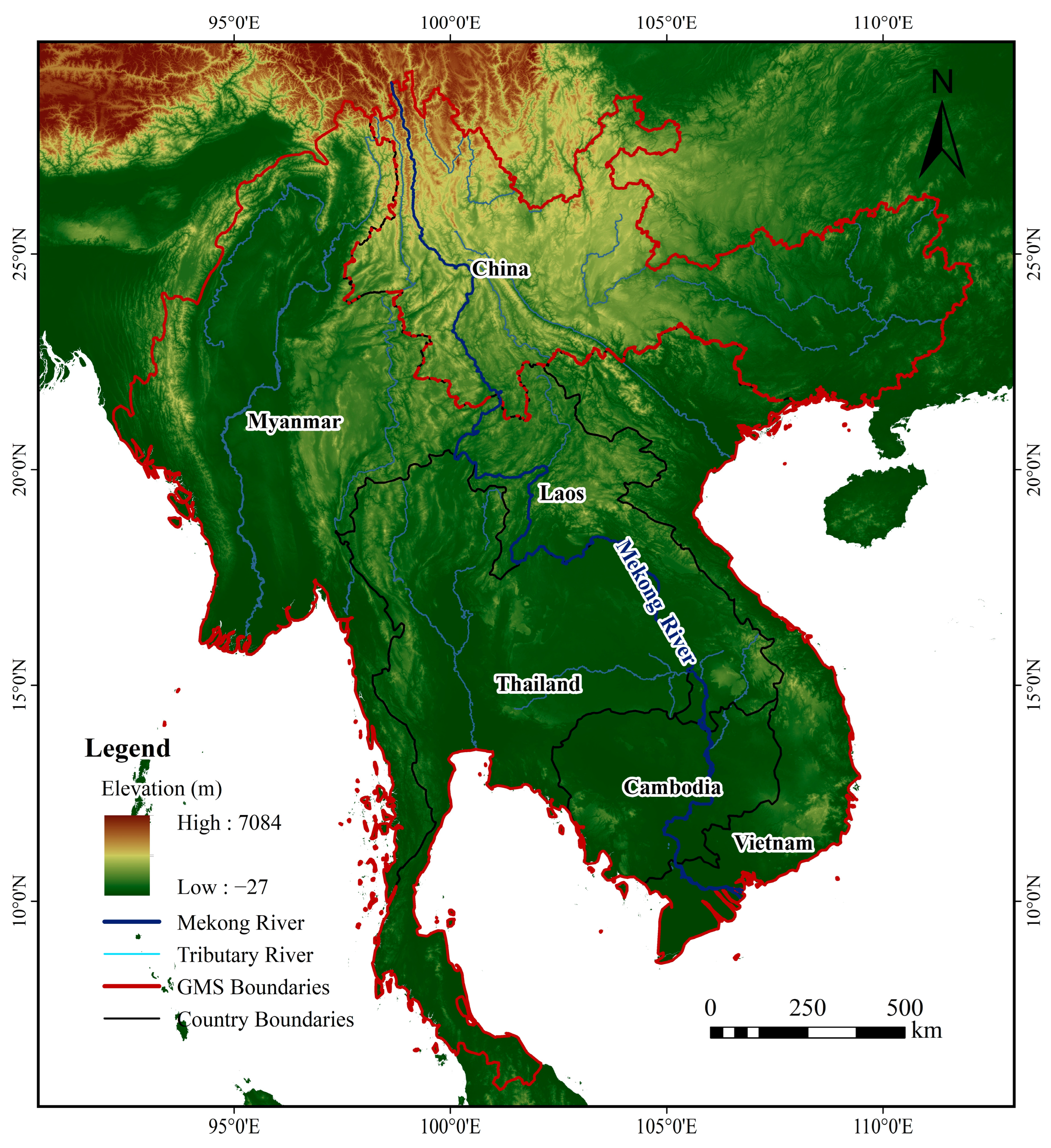
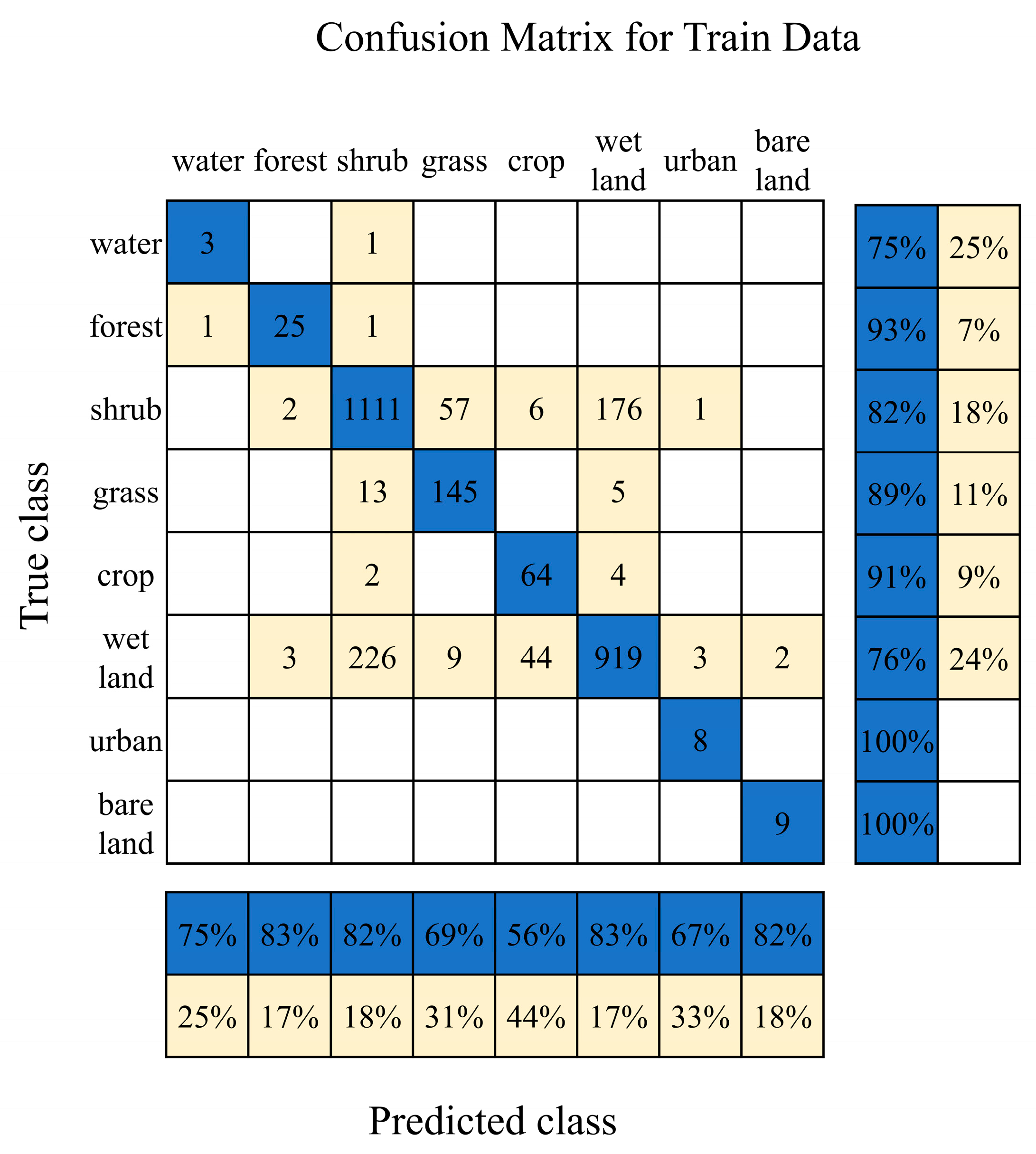
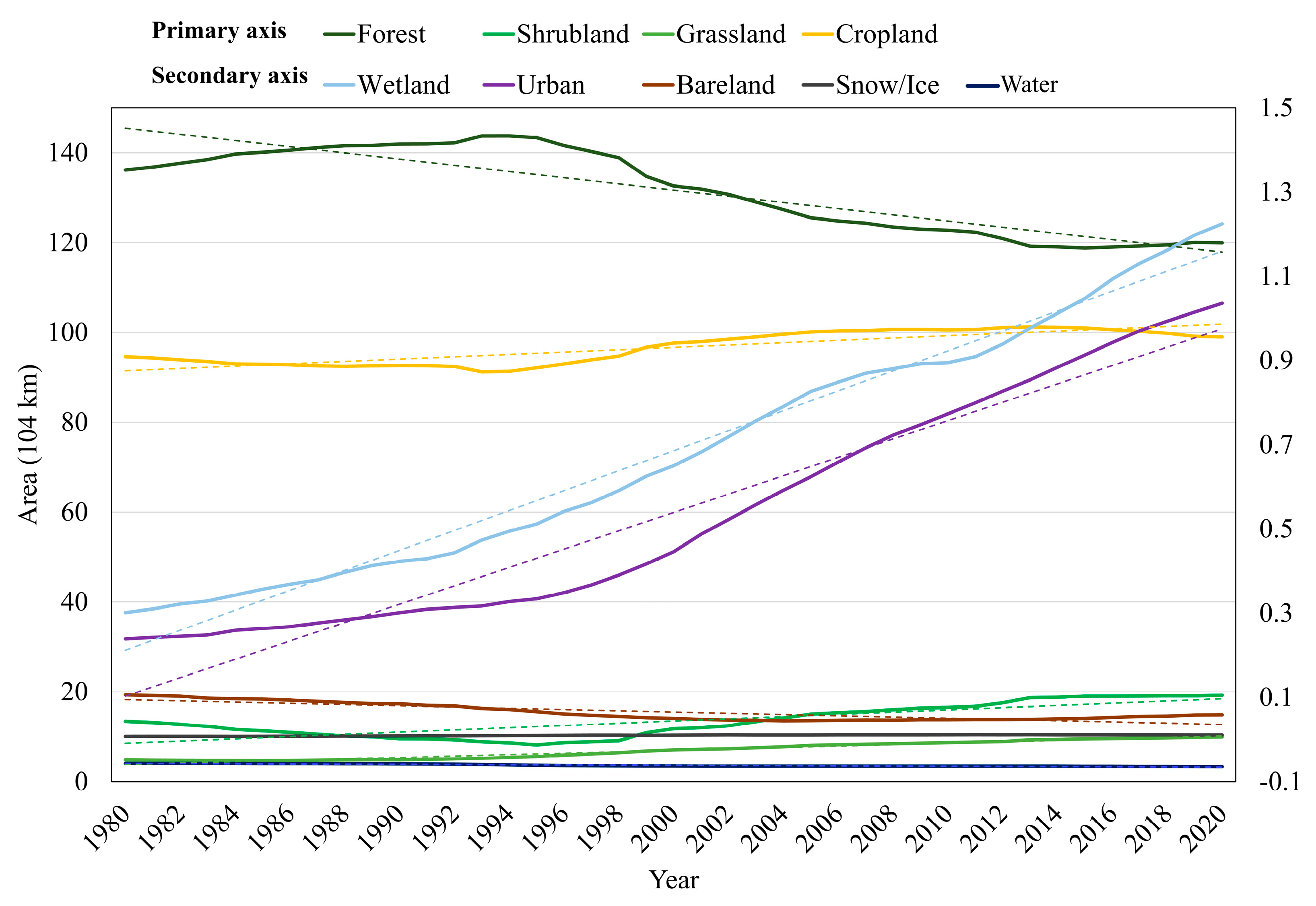


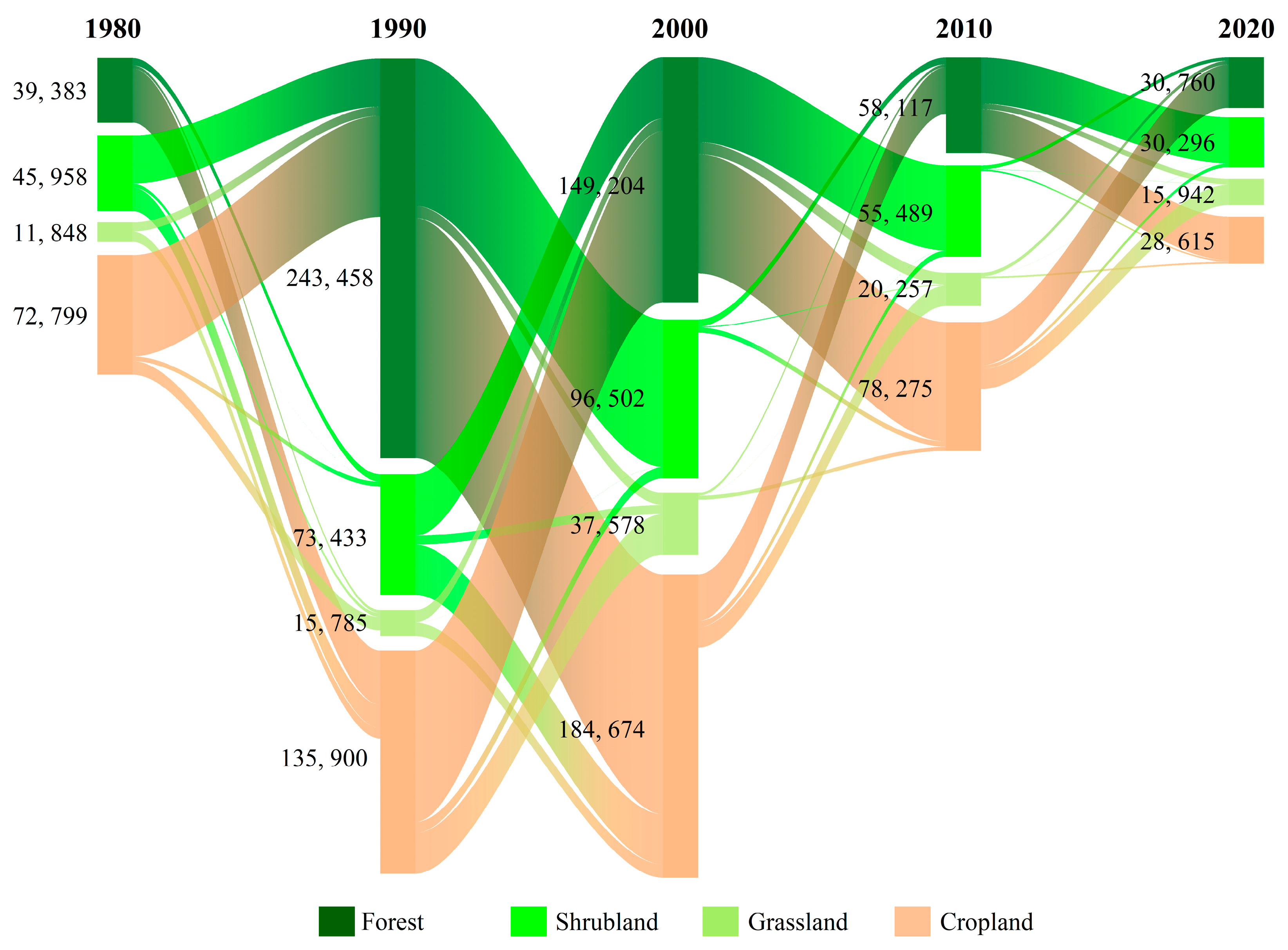
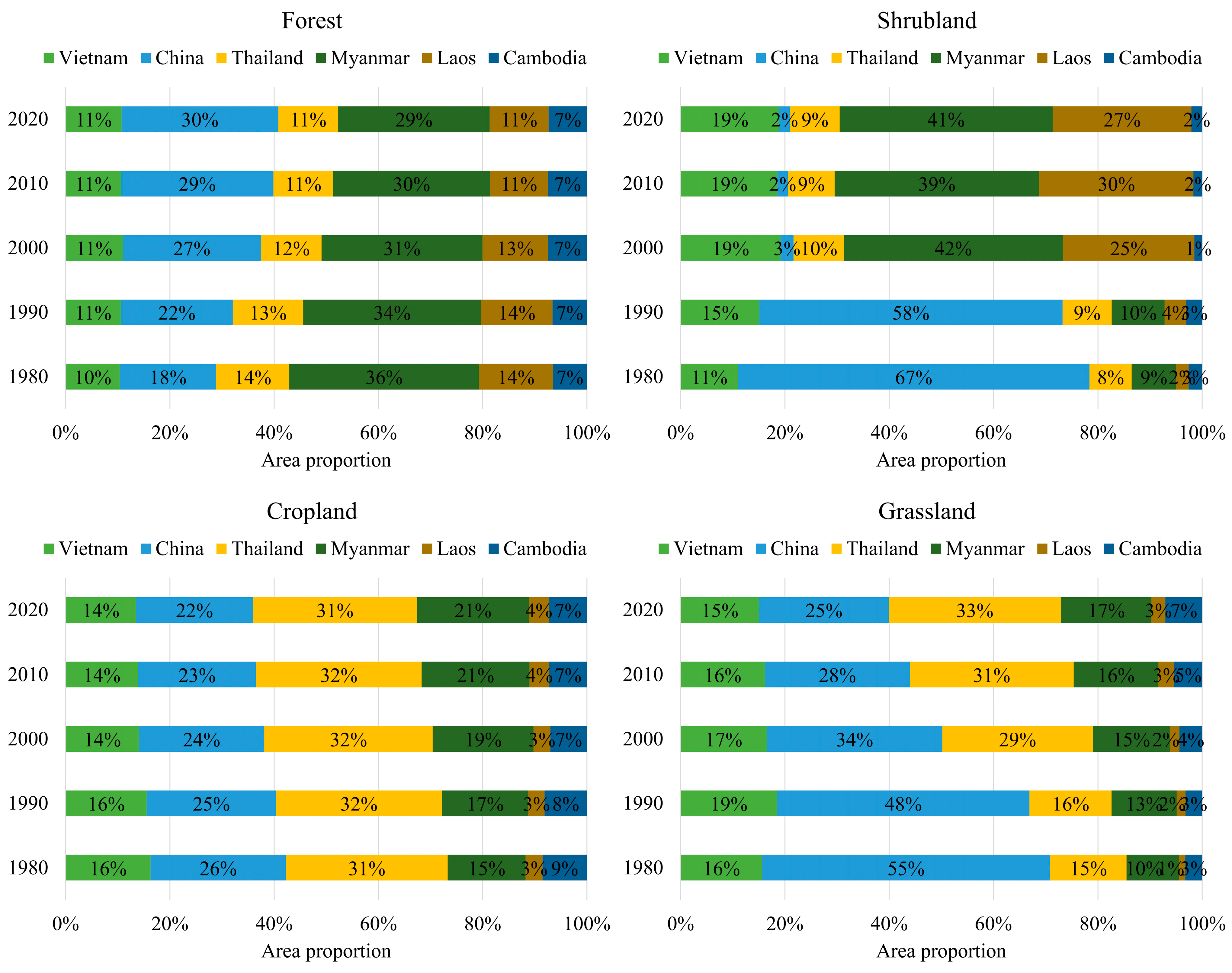

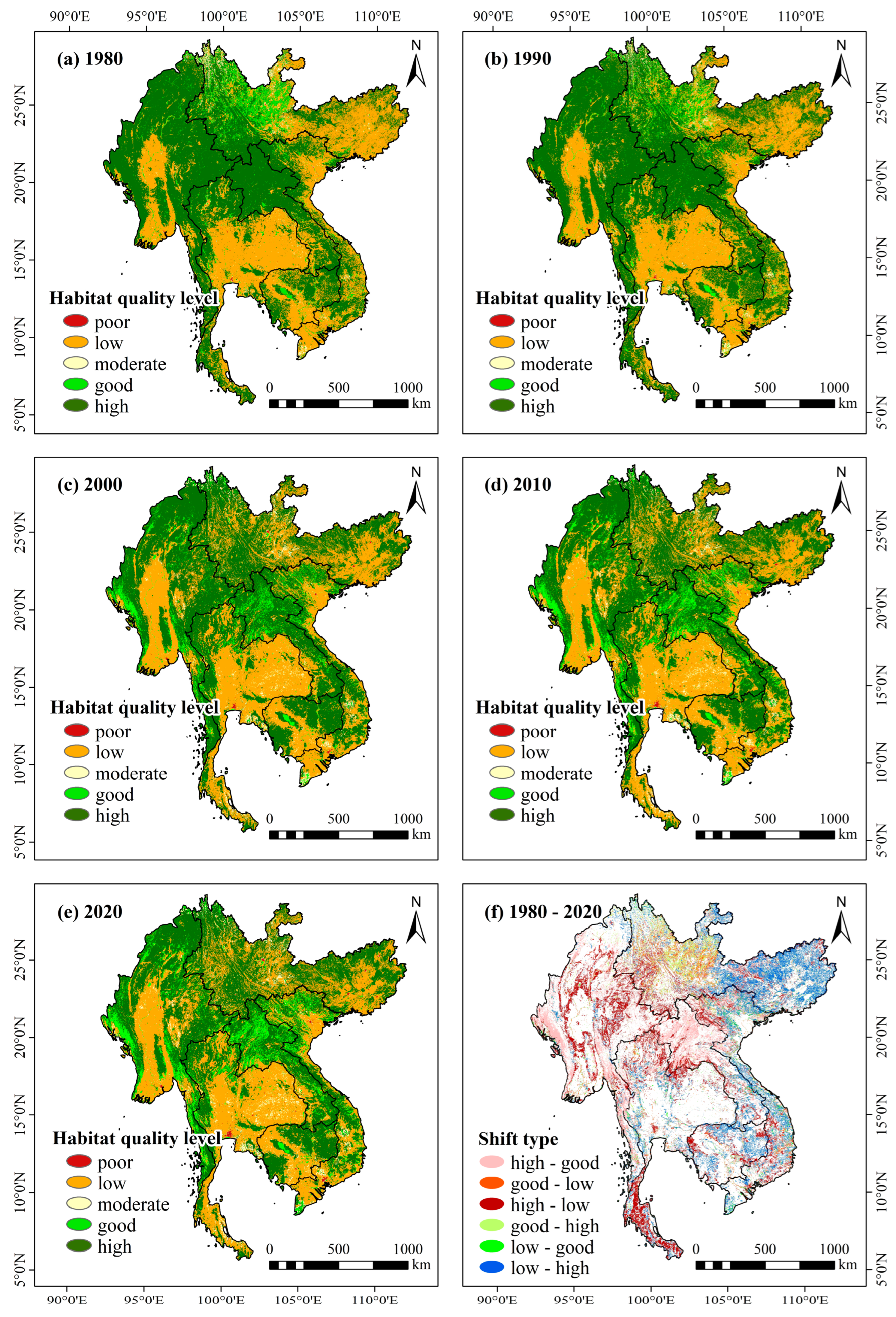
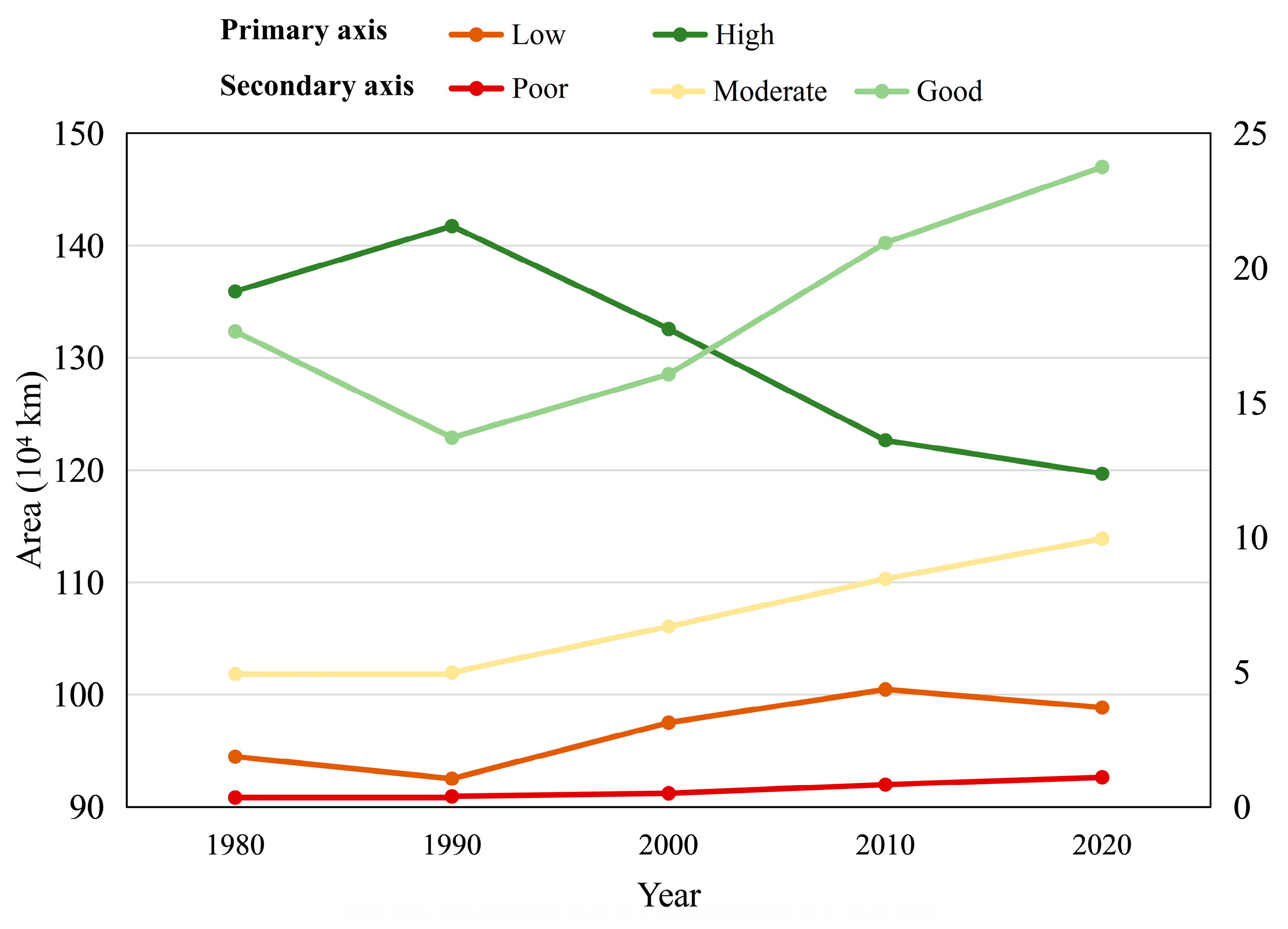



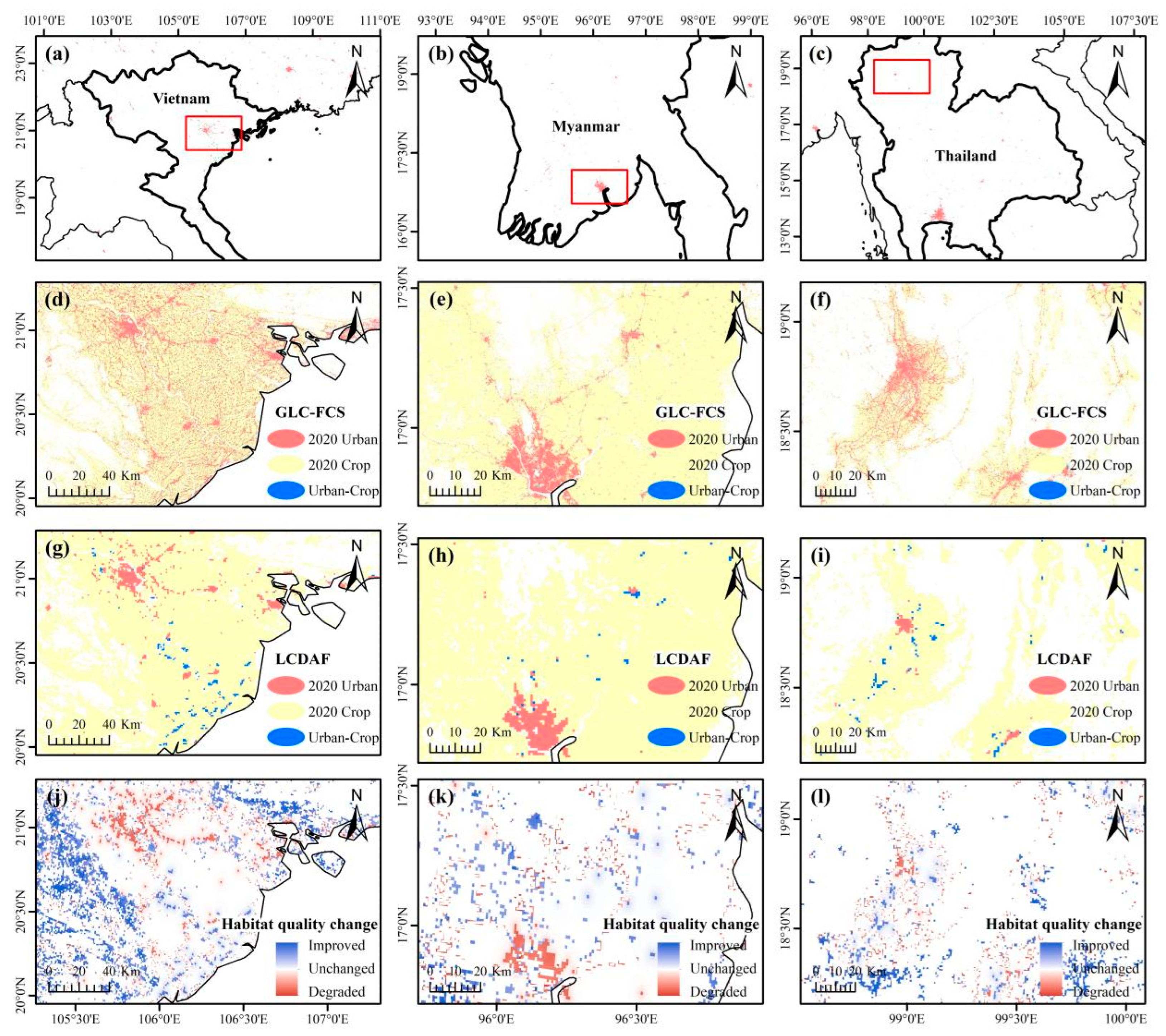
| Short Name | Legend | Sensor | Spatial Resolution | Time | Estimated Uncertainty |
|---|---|---|---|---|---|
| GLCC | IGBP | AVHRR | 1 km | 1992–1993 | 30% |
| GLC2000 | FAO LCCS | SPOT4 | 1 km | 2000 | 40% |
| UMDLC | Simplified IGBP | AVHRR | 1 km | 1987 | 70% |
| CCI-LC 2000 | FAO LCCS | MERIS | 300 m | 2000 | 20% |
| CCI-LC 2005 | FAO LCCS | MERIS | 300 m | 2005 | 20% |
| CCI-LC 2010 | FAO LCCS | MERIS | 300 m | 2010 | 20% |
| CCI-LC 2012 | FAO LCCS | MERIS | 300 m | 2012 | 20% |
| CCI-LC 2015 | FAO LCCS | MERIS | 300 m | 2015 | 20% |
| MODIS 2001 | IGBP | MODIS | 500 m | 2001 | 40% |
| MODIS 2003 | IGBP | MODIS | 500 m | 2003 | 40% |
| MODIS 2005 | IGBP | MODIS | 500 m | 2005 | 40% |
| MODIS 2007 | IGBP | MODIS | 500 m | 2007 | 40% |
| MODIS 2017 | IGBP | MODIS | 500 m | 2017 | 40% |
| MODIS 2019 | IGBP | MODIS | 500 m | 2019 | 40% |
| Threat Factors | Maximum Threat Distance (km) | Weight | Spatial Decay Type |
|---|---|---|---|
| Cropland | 4 | 0.6 | exponential |
| Urban | 8 | 0.8 | exponential |
| Land Cover Type | Habitat Adaptability | Cropland | Urban |
|---|---|---|---|
| Water | 0.9 | 0.7 | 0.9 |
| Forest | 1 | 0.6 | 0.8 |
| Shrubland | 0.9 | 0.5 | 0.6 |
| Grassland | 0.8 | 0.3 | 0.5 |
| Cropland | 0.5 | 0.2 | 0.5 |
| Wetland | 1 | 0.6 | 0.9 |
| Urban | 0 | 0 | 0 |
| Bareland | 0.1 | 0.1 | 0.1 |
| Snow/Ice | 0 | 0 | 0 |
| Products | Accuracy (%) | ||||||
|---|---|---|---|---|---|---|---|
| Global (2000–2013) | GMS (2020) | ||||||
| Time | Name | GLC2000ref | GlobCover 2005ref | STEP | VIIRS | Average | Random Samples |
| 1980–2020 | LCDAF | 67.2 | 79.0 | 78.6 | 70.9 | 73.9 | 80.4 |
| 2000 | GLC2000 | 61 | / | 59.1 | 55.1 | 58.4 | / |
| 2000–2015 | CCI_LC | 58.4 | 76.7 | 64.7 | 60.3 | 65.0 | / |
| 2001–2019 | MODIS_LC | 65 | 76.3 | 79.6 | 71.3 | 73.1 | / |
| Indicator | Water | Forest | Shrub | Grass | Crop | Wetland | Urban | Bareland |
|---|---|---|---|---|---|---|---|---|
| Precision | 0.75 | 0.83 | 0.82 | 0.69 | 0.56 | 0.883 | 0.67 | 0.82 |
| Recall | 0.75 | 0.93 | 0.82 | 0.89 | 0.91 | 0.76 | 1.00 | 1.00 |
| Land Cover | 1980 | |||||||||
| Water | Forest | Shrubland | Grassland | Cropland | Wetland | Urban | Bareland | Snow/Ice | ||
| 2020 | Water | 19,432 | 2207 | 917 | 733 | 9313 | 80 | 41 | 307 | 0 |
| Forest | 5035 | 891,037 | 69,954 | 14,586 | 217,668 | 842 | 42 | 44 | 0 | |
| Shrubland | 393 | 171,361 | 4695 | 115 | 15,599 | 0 | 9 | 0 | 0 | |
| Grassland | 1644 | 18,339 | 7965 | 15,561 | 55,177 | 42 | 40 | 413 | 41 | |
| Cropland | 11,779 | 274,024 | 49,750 | 16,059 | 636,775 | 226 | 1016 | 165 | 0 | |
| Wetland | 1378 | 4419 | 288 | 340 | 3947 | 1819 | 0 | 55 | 0 | |
| Urban | 405 | 362 | 627 | 423 | 7300 | 1 | 1239 | 2 | 0 | |
| Bareland | 69 | 27 | 117 | 68 | 242 | 0 | 0 | 55 | 8 | |
| Snow/Ice | 0 | 0 | 41 | 18 | 6 | 0 | 0 | 17 | 21 | |
| Habitat Quality | 1980 | |||||
| Poor | Low | Moderate | Good | High | ||
| 2020 | Poor | 1343 | 7547 | 1097 | 822 | 2405 |
| Low | 1181 | 636,796 | 18,030 | 62,067 | 271,756 | |
| Moderate | 281 | 57,490 | 12,386 | 10,441 | 19,117 | |
| Good | 599 | 28,944 | 4456 | 27,486 | 176,297 | |
| High | 112 | 215,248 | 13,434 | 75,934 | 893,617 | |
| Products | Accuracy (%) | |||||
|---|---|---|---|---|---|---|
| Time | Name | GLC2000 ref | GlobCover 2005ref | STEP | VIIRS | Average |
| 1980–2020 | LCDAF | 44.4 | 83.3 | 50.0 | 75.7 | 63.4 |
| 1985–2020 | GLC-FCS | 55.6 | 66.7 | 70.8 | 74.2 | 66.8 |
Disclaimer/Publisher’s Note: The statements, opinions and data contained in all publications are solely those of the individual author(s) and contributor(s) and not of MDPI and/or the editor(s). MDPI and/or the editor(s) disclaim responsibility for any injury to people or property resulting from any ideas, methods, instructions or products referred to in the content. |
© 2025 by the authors. Licensee MDPI, Basel, Switzerland. This article is an open access article distributed under the terms and conditions of the Creative Commons Attribution (CC BY) license (https://creativecommons.org/licenses/by/4.0/).
Share and Cite
Liu, S.; Sun, T.; Ciais, P.; Zhang, H.; Fang, J.; Fang, J.; Gemechu, T.M.; Chen, B. Assessing Habitat Quality on Synergetic Land-Cover Dataset Across the Greater Mekong Subregion over the Last Four Decades. Remote Sens. 2025, 17, 1467. https://doi.org/10.3390/rs17081467
Liu S, Sun T, Ciais P, Zhang H, Fang J, Fang J, Gemechu TM, Chen B. Assessing Habitat Quality on Synergetic Land-Cover Dataset Across the Greater Mekong Subregion over the Last Four Decades. Remote Sensing. 2025; 17(8):1467. https://doi.org/10.3390/rs17081467
Chicago/Turabian StyleLiu, Shu’an, Tianle Sun, Philippe Ciais, Huifang Zhang, Junjun Fang, Jingchun Fang, Tewekel Melese Gemechu, and Baozhang Chen. 2025. "Assessing Habitat Quality on Synergetic Land-Cover Dataset Across the Greater Mekong Subregion over the Last Four Decades" Remote Sensing 17, no. 8: 1467. https://doi.org/10.3390/rs17081467
APA StyleLiu, S., Sun, T., Ciais, P., Zhang, H., Fang, J., Fang, J., Gemechu, T. M., & Chen, B. (2025). Assessing Habitat Quality on Synergetic Land-Cover Dataset Across the Greater Mekong Subregion over the Last Four Decades. Remote Sensing, 17(8), 1467. https://doi.org/10.3390/rs17081467








